Fugu Fear Factor
 After my fantastic introduction to the production process at Dassai, Mr. Sakurai Sr. and Mr. Sakurai Jr took me out for a fantastic all-blowfish dinner. Known as “Fugu” in Japanese, yes… it is that deadly, poisonous fish. Yeah, that’s the fish you need to have two years of training and a special license to cut and serve. Wikipedia tells me that According to the Japanese Health, Labor and Welfare Ministry, 14 people died of blowfish poisoning between 2002 and 2006.
After my fantastic introduction to the production process at Dassai, Mr. Sakurai Sr. and Mr. Sakurai Jr took me out for a fantastic all-blowfish dinner. Known as “Fugu” in Japanese, yes… it is that deadly, poisonous fish. Yeah, that’s the fish you need to have two years of training and a special license to cut and serve. Wikipedia tells me that According to the Japanese Health, Labor and Welfare Ministry, 14 people died of blowfish poisoning between 2002 and 2006. 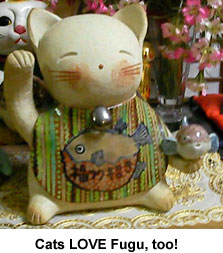 To top it off – Fugu is a total prized and very expensive. If my hosts weren’t concerned, why should I be?
To top it off – Fugu is a total prized and very expensive. If my hosts weren’t concerned, why should I be?
Well… at the restaurant, I did ask to see the fugu license of the nice lady cutting up our blowfish, but everyone just laughed. gulp.
The restaurant itself was totally quaint and very much that hidden type of place you would never know about unless you were recommended there by a friend of a friend. Not only to they run a restaurant, they also farm their own Fugu!
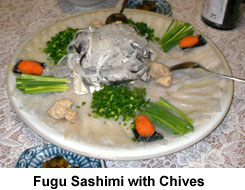 Our first course was a heaping plate of Blowfish sashimi. Mr. Sakurai showed me his preferred method of eating it. wrap each slice with a bit of chive and the shredded daikon-carrot like stuff. It was delicious. Since my limbs didn’t begin tingling, I quickly forgot about the possibility of poisoning and began to seriously chow down. The texture was quite firm, almost meaty, yet smooth and silky. Delicious!
Our first course was a heaping plate of Blowfish sashimi. Mr. Sakurai showed me his preferred method of eating it. wrap each slice with a bit of chive and the shredded daikon-carrot like stuff. It was delicious. Since my limbs didn’t begin tingling, I quickly forgot about the possibility of poisoning and began to seriously chow down. The texture was quite firm, almost meaty, yet smooth and silky. Delicious!
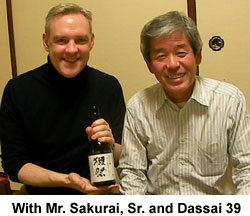 Mr. Sakurai brought 2 bottles of Dassai along for our dinner. We had both a Dassai 39 Centrifuge and a Dassai 50 Sparkling Nigori. Both were fantastic. The Centrifuge sake is unique. that final production process adds “a little something extra” to the flavor and texture on the tongue. The Sparkling Nigori is Fantastic – it opens with a POP just like you get from champagne. Very festive and fun – perfect for celebration. The bottle comes with an extra hang tag to alert people to open the
Mr. Sakurai brought 2 bottles of Dassai along for our dinner. We had both a Dassai 39 Centrifuge and a Dassai 50 Sparkling Nigori. Both were fantastic. The Centrifuge sake is unique. that final production process adds “a little something extra” to the flavor and texture on the tongue. The Sparkling Nigori is Fantastic – it opens with a POP just like you get from champagne. Very festive and fun – perfect for celebration. The bottle comes with an extra hang tag to alert people to open the 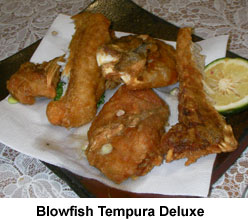 bottle like champagne. the stopper will fly out! I’m sure this has surprised a few Dassai Sparkling drinkers in the past – it’s not what you expect from a sake, but it is terrific fun.
bottle like champagne. the stopper will fly out! I’m sure this has surprised a few Dassai Sparkling drinkers in the past – it’s not what you expect from a sake, but it is terrific fun.
Next we each got a plate of deep fried Fugu Tempura. The axiom that everything tastes better deep fried definitely holds true for Blowfish. It was crispy and offered a different angle on the flavor of fugu. The Nigori meshed with the tempura like and hand in glove. my favorite pairing of the night!
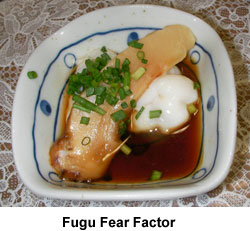 The next course was a bit of a “Lost in Translation” moment. We were each served a small square dish with white something or other in there. I asked what it was, and after a little back and forth and some confusion, I finally understood they were male fugu private parts! I actually can’t tell you how they taste. This fear factor moment pushed me to my limit. Fear was a factor for me! as I sat there staring at the fugu reproductive organs, chopsticks in hand… unsure how to proceed… time for another sip of sake.
The next course was a bit of a “Lost in Translation” moment. We were each served a small square dish with white something or other in there. I asked what it was, and after a little back and forth and some confusion, I finally understood they were male fugu private parts! I actually can’t tell you how they taste. This fear factor moment pushed me to my limit. Fear was a factor for me! as I sat there staring at the fugu reproductive organs, chopsticks in hand… unsure how to proceed… time for another sip of sake.
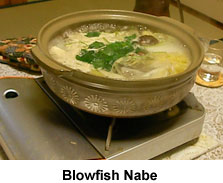 Luckily, our hostess quickly arrived with a glorious, steaming pot of Fugu and vegetable stew called “Nabe”. This dish came with a bowl for the fugu bones. Nabe is now one of my new favorite things! It was warming and hearty and the fugu added a great depth of flavor to the broth. after all the fugu was fished out and picked clean, the hostess filled the bowl with rice. it was two, two, two dishes in one! and boy was I getting full!
Luckily, our hostess quickly arrived with a glorious, steaming pot of Fugu and vegetable stew called “Nabe”. This dish came with a bowl for the fugu bones. Nabe is now one of my new favorite things! It was warming and hearty and the fugu added a great depth of flavor to the broth. after all the fugu was fished out and picked clean, the hostess filled the bowl with rice. it was two, two, two dishes in one! and boy was I getting full!
 Dessert arrived in the form a cool and refreshing Japanese lime beverage, kinda like a homemade lime-aid. this unexpected treat cleansed the palate and was just about the only thing I had all night that didn’t have Blowfish in it somewhere. Our lovely hostess gave me a fugu tokkuri as a parting gift. I was really touched. On the way out, they also showed me the Fugu tanks and I got to see some live specimens up close and personal. Um, blowfish won’t be winning any beauty pageants. Fugu is kinda Fugly up close, but… it sure does taste good.
Dessert arrived in the form a cool and refreshing Japanese lime beverage, kinda like a homemade lime-aid. this unexpected treat cleansed the palate and was just about the only thing I had all night that didn’t have Blowfish in it somewhere. Our lovely hostess gave me a fugu tokkuri as a parting gift. I was really touched. On the way out, they also showed me the Fugu tanks and I got to see some live specimens up close and personal. Um, blowfish won’t be winning any beauty pageants. Fugu is kinda Fugly up close, but… it sure does taste good.
My sincere thank you to the delightful Sakurai family for this tremendous and delicious evening. A special “arigatogozaimasu!” to the hostess at the fugu restaurant for cutting up my fish in such a way that I won’t be landing on the Japanese Health, Labor and Welfare Ministry statistics for 2007. Kanpai!


